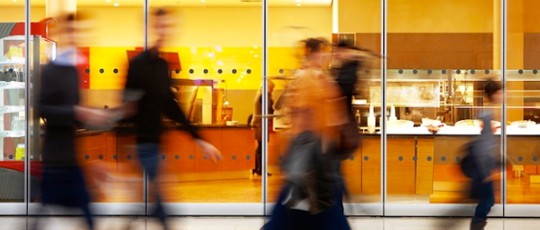The latest data on the commercial property market is out. RPData shows quarterly sales increasing while auction clearance rates are below average. Colliers International indicates that the CBD office market is looking up with investment increasing from domestic investors. Data from Knight Frank reveals a soft Eastern seaboard vacancy in the Industrial sector and stabilizing speculative development.
Quarterly sales improving
February quarterly data saw commercial property sales increase. In Sydney this quarter, there were 96 sales with a total value of $1.019 billion compared with 92 sales with a total value of $906.3 million for the quarter ending November. Annual results have also improved, with 385 sales recorded for a total of $3.919 billion compared with 277 sales for a total of $3.116 billion for year ended February 2014. As the graph below shows this continues the trend of steady improvement in sales since August 2012.

Auction clearance below average
Increasing sales in the Sydney commercial market has not led to a significant jump in commercial auction clearance rates. In the last week of February the rate was recorded at 46.9%. This represented 15 commercial properties sold with a total value of $14,765,000. At the same time last year the rate was just higher at 47.2% across 36 auctions.

The graph below tells a more interesting story than what these figures belie. While rates moved between 50%- 70% for the majority of the year, rates plunged to 18% in late January then subsequently flew up to 78% before coming to settle at the current rate. There is little explanation for this beyond the very simple: a real estate holiday.

A similar dip occurred in the broader real estate market, shown below. The residential market came back into full swing in February with auction listings up 35% on 22nd February from corresponding weekends in 2013. Considering the activity of the market during the later end of 2013, this is a clear sign of strength.

Foreign investment in commercial property declining
Movement in the real estate market has undoubtedly been positively affected by historically low interest rates. Foreign investment has also added a major injection. As the latest data from the Foreign Investment Review Board (FIRB) shows foreigners spent twice as much buying established residential housing in 2012-13 than in 2011-12. Interestingly, this surge has not been mirrored in the commercial property market. In fact, foreign commercial real estate investment decreased from $39.4 billion in 2011-12 to $34.8 billion in 2012-13. The graph below highlights the contrast clearly. While the amount invested in commercial property remains at least three times that of residential property, a clear downward trajectory has emerged.
Foreign investment in Australian real estate ($B)

Foreign investment sliding in CBD office market
This decline has significantly affected the CBD office market. As the graph below outlines from 2012-113 the buyer group with the most significant reduction in the office CBD market was the offshore group, while Australian institutions have increased their share.

Despite the overall decrease in foreign investment, there has been an increase in Chinese investment. In total, Chinese groups purchased $580 million of CBD office property in 2013. The largest purchase was the Centennial Plaza in Sydney. As the graph below reveals Chinese investment outstrips Singapore and Malaysia by at least a third and is more than double that from Canada, USA and Germany.

Overall investment in the CBD office market looks more positive than the level of foreign investment suggests; having increased by 16% on 2012 levels, which is the highest level since 2007. As the graph below indicates this increase was substantially a result of a return to the market of unlisted property funds.

Over the six months to January 2014, take-up of vacant space was 24% lower when compared with the first half of the year. This highlights the slowing momentum in leasing demand in the second half of 2013. There is some scope for leasing demand to show improvement in 2014, particularly in Sydney.
Speculative development pipeline for the Eastern Seaboard
The speculative development pipeline has stabilised over the past few quarters. Despite this, total speculative stock available for lease (both completed and under construction) sits 20% higher than a year prior. The strong demand for high quality, larger accommodation has underpinned reasonably successful outcomes for speculative developments with completed speculative stock recording a fall of 4% over the past quarter.

Conclusion
Whilst the residential property market continues to run, the commercial market is showing mixed signs. The latest data reveals improving sales but mediocre clearance rates. Vacancy levels are very soft in the eastern seaboard. And foreign investment levels have taken a noticeable dive, especially affecting the CBD office space. This has opened up space for unlisted property funds to increase their share of the market. To date, the commercial property has not been as responsive to historically low interest rates as the residential sector. This is perhaps a little surprising, and leaves upside in the commercial sector as consensus interest rate outlooks remain low.




